Authored by Golam Rabbani*,
Abstract
Bangladesh, a low-lying deltaic country recognized as the frontline victims of climate change, has been experiencing climate induced migration since the very beginning. Internal migration trends in the country show migrants from climate hotspots are most likely to move towards their urban counterparts in search of alternative livelihood. To understand the growing interconnections between climatic hazards and growing internal migration, this paper attempts to analyse the temperature and rainfall data of two climate vulnerable districts (Rajshahi and Khulna) of Bangladesh and examine which climatic hazards have affected the two districts most. Further using mixed methodologies this paper also explores the correlation between climate change and increasing internal migration rates in Rajshahi and Khulna. It finally looks into an innovative climate financing mechanism ‘Climate Bridge Fund’ and explores the impacts of the projects that are working towards addressing the climatic hazards of climate migrants of these two areas in the urban informal settlements.
Keywords:Climate migrants; Vulnerabilities; Adaptation; CBF; Bangladesh
Introduction
Bangladesh, a small riverine South Asian country has always survived its share of storms, cyclones, floods, and other natural disasters. While such disasters were considered as natural phenomena, the recent assessment report of the Intergovernmental Panel on Climate Change (IPCC) confirms unequivocal human influence on the climate system, fueling these natural disasters [1]. The indisputable evidence of such human induced climate change includes- increasing prolonged drought, increasing frequency and intensities of cyclones, tropical storms and flash floods and raising sea-level since the beginning of twentieth century [2,3]. Such changes influencing intensities and frequencies of disasters create new patterns of destruction, one of which is climate induced migration and an explosion of rapid, unplanned, and chaotic urbanization in Bangladesh [4].
Climate induced internal migration has enormously grown in the past few decades in the country; with over two-thirds of the population migrating to mega and secondary cities. In 2021 alone, climate induced disasters triggered 99,000 new internal displacements in Bangladesh [5]. Studies have also confirmed that 17% of Bangladesh will be submerged by rising sea levels, increasing the number of climate migrants to 20 million by 2050 [6]. International Organization for Migration also estimated that 70% of Dhaka’s slum-dwellers migrated due to some sort of environmental shock [7,8].The ultimate destination of these climate migrants are the informal settlements of urban areas. These informal settlements, often known as hub for migrants, are characterised by tenure insecurity and evictions, and are controlled by gang-lords charging exorbitant rates for basic services. Further, are also subject to water-logging due to poor drainage; substandard and congested housing putting residents at greater risk during any climate induced disasters.
Given the situation of climate migrants, this research aims to bridge the critical knowledge gaps by analysing the ground level scenario, and via proposing appropriate climate adaptive interventions which were tested and identified as successful low-cost models at informal settlements of climate hotspots of Bangladesh. The objective of this paper lies in identifying the trend of the key climate related primary and secondary hazards which includes- daily maximum temperature, daily minimum temperature, rainfall pattern, heat waves, cold waves, cyclonic events, flood, drought, salinity intrusion, sea level rise (SLR) that are affecting slums of Khulna and Rajshahi the two most climate vulnerable districts of Bangladesh. This research paper also attempts to understand how the recent climate change adaptation project interventions/measures (supported by Climate Bridge Fund) are enhancing adaptive capacity of the climate migrants and vulnerable communities towards adverse impacts of climate change.
Materials and Methods
Study sites
Two districts were selected based on the climate vulnerability- Rajshahi and Khulna. Rajshahi located at the north-western part of the country lies between 24°07′ and 24°43′ north latitudes and between 88°17′ and 88°58′ east longitudes [9]. Rajshahi has a monsoonal climate with high temperature and moderate rainfall with considerable humidity. This district was primarily selected as it is a drought prone zone and people mostly suffer from water scarcity. Additionally, the heat waves in summer and cold waves in winter affect both the health and economy of the people living in Rajshahi.
The second study site was Khulna district. Khulna has a total area of 4394.46 sq km, and is bounded by Jessore and Narail districts on the north. Bay of Bengal surround Khulna on the south and it is located at latitude 22°47’N (22.783) and longitude 89°32’E (89.533) [10]. Khulna district is known to have a tropical wet to dry climate. This district is characterized by tidal flood, frequent cyclones, and high salinity which often impairs agricultural and economic well-being of the people [10].
Data collection and analysis
This study followed a mixed methodology. Both qualitative and quantitative data were used. The temperature and rainfall data for both Khulna and Rajshahi were collected from the Bangladesh Meteorological Department (BMD) between 1981 and 2020. Followed by the trend analysis a textual analysis was done to identify the climatic hazards in Rajshahi and Khulna districts which have affected the two districts most. For textual analysis data were extracted from Google Scholar and other relevant search engines such as Web of Science, Scopus, and Science Direct. Literature present between 2010 and 2020 were considered and reviewed; both journal articles and grey literature were considered. Articles with key words “Climatic Hazards Bangladesh”, “Climatic Hazards Rajshahi”, “Climatic Hazards Khulna”, “Climate Change Adaptation Response”, and “Climate Induced Migration” were used to identify relevant research in the search engines mentioned. Further the study also collected primary data from field visits to the selected study sites. Four community consultation meeting were conducted to understand the situation of the vulnerable communities before and after the climate adaptive interventions supported by Climate Bridge Fund (CBF) Secretariat were implemented.
Data analysis
The research analysed the trend of daily maximum and daily minimum temperature, and daily rainfall data over 40 years long period (1981-2020), from Rajshahi and Khulna meteorological station of BMD. Annual and seasonal trends of both temperature and rainfall were analysed. Mann-Kendal statistical test (MK test) was performed to assess whether the 40 years’ time series value shows an increasing or decreasing trend over time [11]. Through secondary literature review this study found that flood, drought, salinity intrusion, sea level rise (SLR), cyclones, and storm surge to have affected the above-mentioned locations the most. Through community consultation meetings recent adaptation interventions in the selected sites were identified. The identified interventions were Climate Bridge Fund (CBF) Secretariat supported projects and were particularly considered due to the innovativeness.
Result and Discussions
State and trend of climatic hazards that affect rajshahi and Khulna
Maximum temperature pattern: Upon looking at the data collected from BMD during the period 1981-2020, it’s apparent that the temperature in both Rajshahi and Khulna has been rising in the last few decades. Figure 1 shows that the 40 year annual average maximum temperature in Rajshahi follows an increasing trend (0.020C/yr) over the period of 1981-2020, which is statistically significant (p=0.001). In Rajshahi, over the period, the highest annual average maximum temperature (32.2°C) was observed in 2016 whereas the lowest (29.8°C) was in 1981. However, with the current positive trend (0.020C/yr) from 1981, it is expected that average maximum temperature will increase by at least 1.2°C, 1.6°C and 2.6°C in 2030, 2050 and 2100 respectively.
Respondents in the city of Rajshahi were asked about the impacts of climate change, 94.66% of the respondents mentioned that the temperature is rising at an alarming rate and that their living conditions have become unbearable during warmer seasons.
In Khulna, annual average maximum temperature (Figure 1) also shows an increasing trend (0.0020C/yr) which is statistically significant (p=0.0005). With the positive trend (0.020C/yr) from 1981, Khulna’s average maximum temperature will be increased by at least 1.2°C, 1.6°C and 2.7°C in 2030, 2050 and 2100 respectively. The data provided evidence that annually, the days in both Rajshahi and Khulna are getting increasingly hotter (Figure 1).

Maximum temperature pattern across the seasons
While the data indicates that the average maximum temperature has been on the rise annually, breaking it down seasonally shows further interesting results. The data indicates that while some seasons are witnessing average maximum temperature rises, other seasons are showing a decreasing trend in the average maximum temperature. In Rajshahi, average maximum temperature for the period of 1981-2020 was on a decreasing trend in winter and pre-monsoon. On the other hand, with the application of MK test, the average maximum temperature in monsoon (p=0.0001) and post-monsoon (p=0.0001) showed a statistically significant increasing trend over the period of 1981-2020 in Rajshahi. The rate of increase in monsoon and post-monsoon trend was observed at 0.06°C/yr and 0.03°C/yr respectively. In Khulna, average maximum temperature was on an increasing trend in every season. However, the trend in monsoon (p=0.00001) and post-monsoon (p=0.0001) shows statistically significant. The rate of increase in monsoon and post-monsoon trends was observed to be 0.04°C/yr. and 0.03°C/ yr. respectively. The data provide clear evidence that annually, the days in most seasons, both in Rajshahi and Khulna are getting increasingly hotter. But interestingly the days in winter and premonsoon seasons in Rajshahi are expected to get cooler.
Minimum Temperature pattern
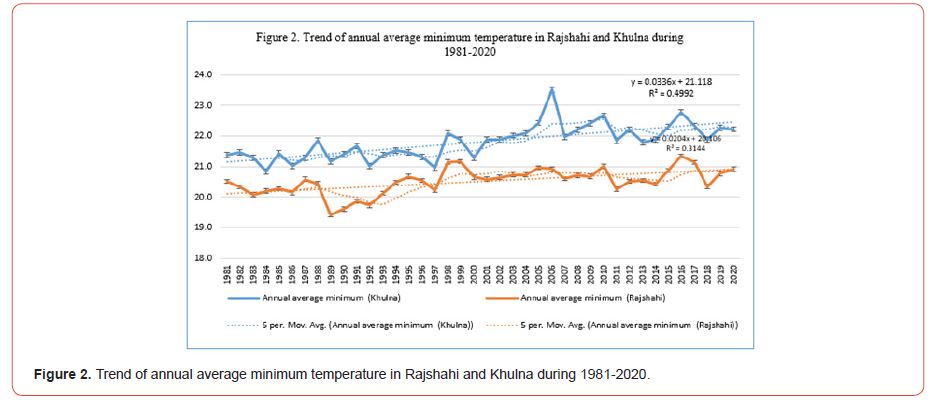
By looking at the average minimum temperatures (Night-time temperatures) between the period of 1981-2020 of both Khulna and Rajshahi depicts clear changes. Annual average minimum temperature in Rajshahi (Figure 2) was on an increasing trend (0.020C/yr) during 1981-2020, which is statistically significant (p=<0.0003). With the current positive trend (0.020C/yr) from 1981, it is expected that average minimum temperature will be increased by at least 0.6°C, 1.0°C and 2.0°C in 2030, 2050 and 2100 respectively in Rajshahi (Figure2).
In Khulna, annual average minimum temperature (Figure 2) also shows an increasing trend (0.030C/yr) which is also statistically significant (p=<0.0001). With the current positive trend (0.030C/ yr.) from 1981, it is expected that average minimum temperature will be increased at least 1.1°C, 1.7°C and 3.2°C in 2030, 2050 and 2100 respectively in Khulna.
Minimum temperature pattern across the seasons
The data shows that the night time temperatures are increasing sharply in almost every season in both Rajshahi and Khulna. However, night time temperatures in Rajshahi during winter season are trending towards a cooler temperature. On a seasonal trend in Rajshahi average minimum temperature for the period of 1981-2020 was on a decreasing trend in winter. With application of the MK test, the average minimum temperature in pre-monsoon (p=0.004), monsoon (p=<0.0001) and post-monsoon (p=0.04) showed increasing trend with statistical significance, over the period of 1981-2020 in Rajshahi. The rate of increase in average minimum temperatures during pre-monsoon, monsoon and postmonsoon trend was observed at 0.03°C/yr., 0.03°C/yr. and 0.02°C/ yr. respectively. In Khulna, average minimum temperature was on an increasing trend in every season. This increasing trend in each of the seasons is statistically significant during the mentioned period.
Rainfall pattern
Throughout the years, communities in both Rajshahi and Khulna have reported that there have been significant changes in rainfall patterns in their regions. Rajshahi has experienced a decreased amount of rainfall throughout the years, however, communities in Khulna have reported on multiple occasions that they are witnessing an increased number of rainfall events. In order to examine the scenario, data regarding the frequency of rainfall was collected from BMD to identify the trends in rainfall over the 40-year period (1981-2020). Trend of annual, seasonal total rainfall and rainy days during the period of 1981-2020 was observed for Rajshahi and Khulna. During 1981-2020, the annual rainfall (total) in Rajshahi (Figure 3) shows a sharp decreasing trend (-8.13 mm/yr) with statistical significance (p=0.025) while there is a statistically non-significant decreasing trend (-0.65 mm/ yr) in Khulna (Figure 3).
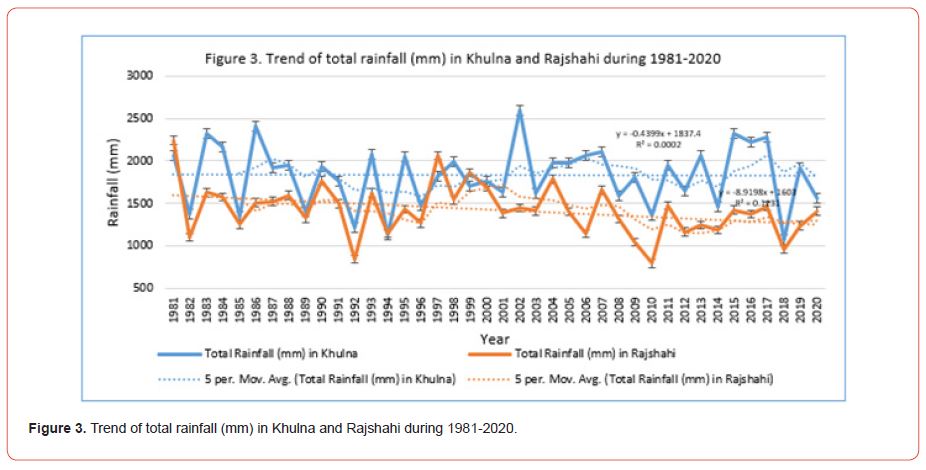
With the current decreasing trend (-8.215mm/yr.) from 2020, it is expected that the annual rainfall will be decreased by at least (-82 mm), (-246 mm) and (-657 mm) in 2030, 2050 and 2100 respectively in Rajshahi. In other words, Rajshahi’s rainfall is expected to be nearly half by the end of 2100. In Khulna, the annual rainfall will decrease by at least (-6.5 mm), (-19.6 mm) and (-52.24 mm) in 2030, 2050 and 2100. In other words, Khulna’s rainfall will be decreased but roughly will not make any significant change (Figure 3).
In the seasonal total rainfall pattern in Rajshahi (Figure 4), winter, monsoon and post-monsoon followed a decreasing trend while pre-monsoon indicates an increasing trend for the period of 1981-2020. Monsoon rainfall in Rajshahi depicts a decreasing trend (-5.56 mm/yr) with statistical significance (p=0.027) (Figure4).
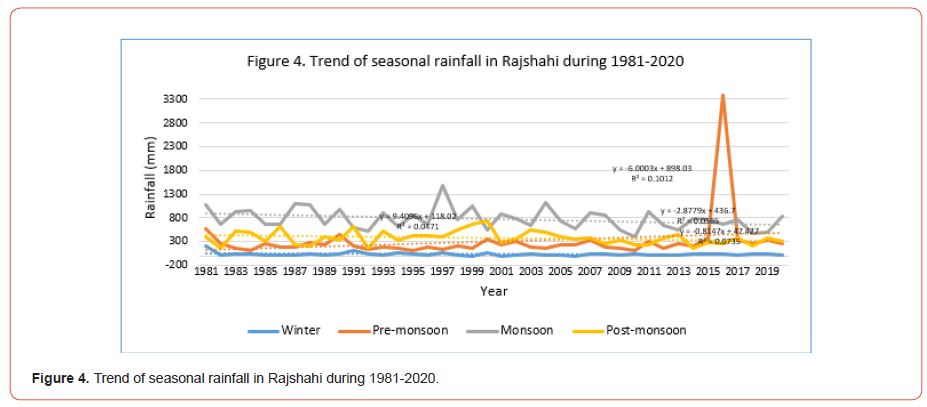
While in Khulna, there is a decreasing trend (Figure 5) in winter and pre-monsoon rainfall, there is an increasing trend in monsoon and post-monsoon rainfall. Khulna’s seasonal rainfall indicates a statistical non-significant trend for the period of 1981-2020. The increase in heavy rainfall in Khulna is especially alarming as it exacerbates complexities. For example, challenges due to the inadequate number of poorly built latrines throughout low-income communities can worsen the situation. It is a common within slums throughout Khulna to use community latrines by multiple families, and often, the excessive usage of community latrines, coupled with flooding due to rainfalls causes overflows and therefore causes environmental pollutions as raw sewage escapes [12] (Figure 5).
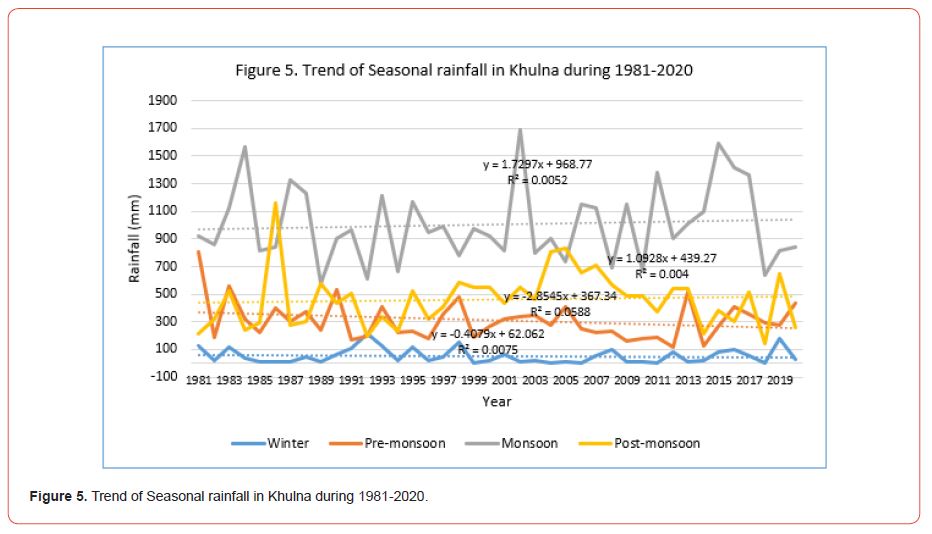
This research also observed the trend of days without rainfall in both locations during 1981-2020. Figure 6 illustrates the trend of days with >25 mm and >50mm rainfall in both locations for the same period. It also indicates that the number of days without rainfall was on the increasing trend in both Rajshahi and Khulna. It indicates that the trend of the number of days without rainfall in Rajshahi was increasing by (0.31 days/yr.) with statistical significance (p=0.029) while it was observed as a statistically nonsignificant increasing trend (0.31 days/yr.) in Khulna (Figure6).
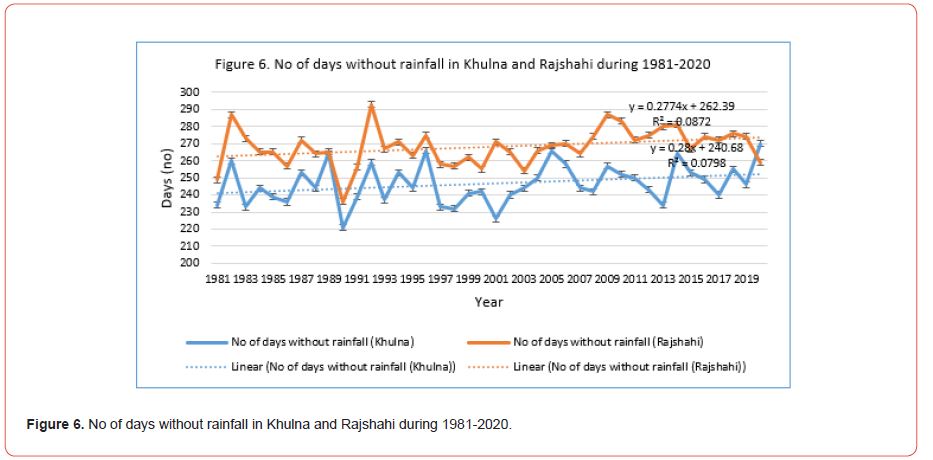

The trend of days with >25 mm and >50mm rainfall show a decreasing trend in Rajshahi (Figure 7) while it is on an increasing trend in Khulna (Figure 8). However, the decreasing trend of days with >25 mm rainfall in Rajshahi is statistically significant (p=0.018).(Fingure7). and (Figure8).
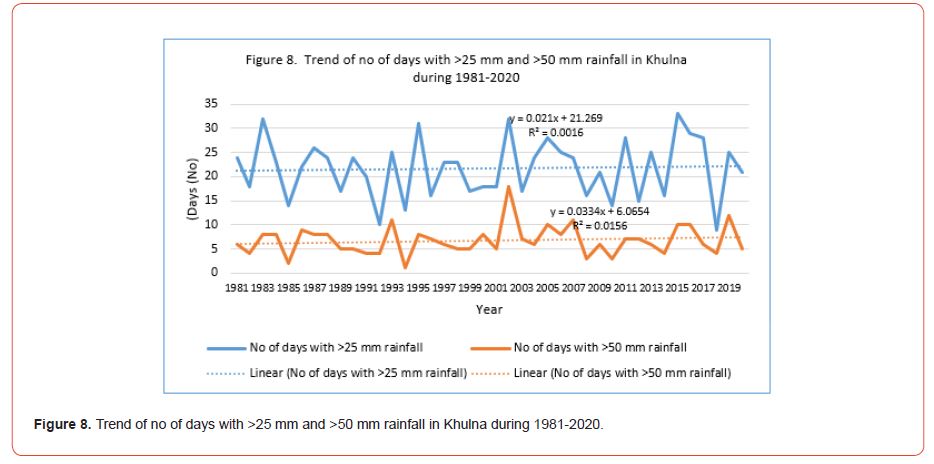
Heat waves
Frequent heat waves are also on the rise for both locations. The data indicates that the frequency of heatwaves sharply increased for both cities over the 40-year period. Heatwaves are generally classified into 4 categories: mild heat waves (36 °C- 38°C), moderate heat waves (38°C- 40°C), severe heat waves (40°C-42°C) and extreme heat waves (>42°C) [13].
No of days with >36°C shows statistically non-significant increasing trend for the 40 year period in Rajshahi. Figure 9 clearly indicates that the number of days with >36 °C increased from 6 days in 1981 to 31 days in 2020 (+0.5 day/yr), which may be increased to 36 days, 46 days, and 71 days in 2030, 2050 and 2100 respectively. The days with heat waves (>36°C) were observed highest (75 days) in 2014 and the lowest (6 days) in 1981. In addition, Rajshahi was exposed to 11 to 16 days of severe to extreme heat wave (>40°C) six times during the 40 years study period. While in Khulna, the trend of the number of days with >36 °C has increased (Figure 10) from 2 days in 1981 to 18 days in 2020 (0.44 day/yr). With the current trend, it is expected that Khulna’s heat wave days (>36 °C) will be increased to 22.2 days, 31.2 days, and 53.2 days in 2030, 2050 and 2100. Though Khulna experienced a severe heat wave (>40°C) in only 11 days in total in four different years during 1981-2020, moderate to severe heat waves (38°C- 40°C) was observed every year in the study period.
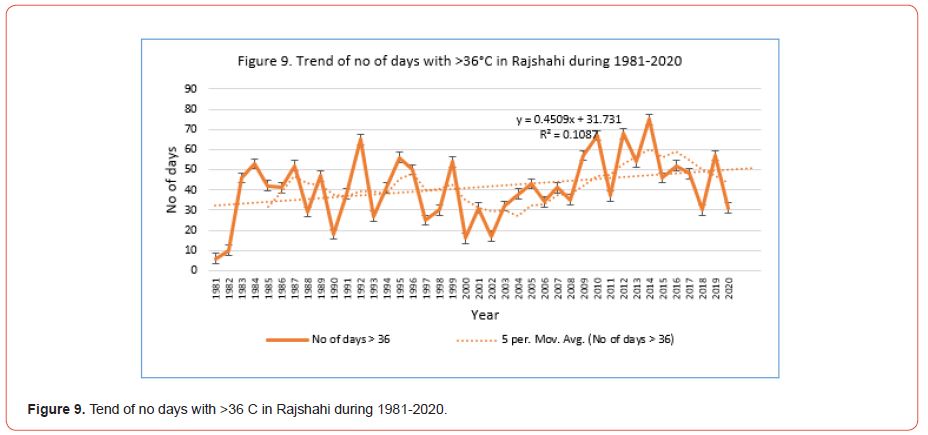
In comparison, the heat wave days in total with >36°C was observed 41.5 % higher in Rajshahi than in Khulna in 40 years study period. In addition, heat wave days were observed highest in the last decade (2011-2020) [Rajshahi = 498 days, Khulna=317 days] and the lowest in the first decade (1981-1990) [Rajshahi = 344 days, Khulna=193 days]. (Figure9). and (Figure10).

Cold waves in Rajshahi and Khulna
Cold waves are considered under the temperature <10 °C [13]. During 1981-2020, trend of number of days with <10°C shows an increasing statistically non-significant decreasing trend in Rajshahi. Figure11 indicates that the number of days with (<10°C) increased from 10 days in 1981 to 24 days in 2020 (+0.3 day/year). Rajshahi experienced at least 33 days to 39 days with cold waves (<10°C) in six years (1984, 1989, 1992, 2010, 2011 and 2018) out of a 40 year study period.(Figure11).

While in Khulna, trend of no. of days with >10°C (p= 0.0003) is on decrease with statistical significance for the above-mentioned period. It indicates that cold days (<10°C) have declined from 7 days in 1981 to “0” days in 2020 (-0.2 day/yr.) in Khulna. In other words, cold days are sharply decreasing in Khulna (Figure 12).

Cyclone and Storm Surges in Khulna
Globally, one of the recent predictions is that the frequencies of tropical cyclones would decrease while the very severe cyclonic events would increase under 3 to 4 °C. Some other reports also denote an increase of the intensity of the cyclonic events in the Bay of Bengal since 1970 [14]. It has been recorded that around 154 cyclones hit Bangladesh between the year 1877 and 1995, among which 43 of them were severe cyclonic storms [15]. The cyclone history indicates that 42 cyclonic events affected South-West coastal region (greater Khulna) during 1877-2022 (modified from [16]). Figure13 shows the number of cyclonic events that affected in different months of the year between 1877 and 2022 (till June) in the southwest coast. It indicates that cyclones usually hit the Southwest coast between May and November. It also indicates that the occurrence of the cyclonic events was highest (18) in postmonsoon and the second highest (16) was in monsoon.(Figure13).

Sea Level Rise (SLR) and salinity intrusion in Khulna
In Bangladesh, the coastal zone is experiencing a 6-20 mm/ year rise of the sea level which may result in an increase to around 2-metre sea level rise by the end of 2100 [17]. It also indicates that the coastal flooding might be increased due to excessive rainfall associated with cyclonic events combined with increased sea level rise [18]. In addition, sea level rise would cause a decrease in freshwater river from 40.8% in 2012 to 17.1%- 19.7% in 2050 in the southwest coast of Bangladesh [1]. Projected SLR would displace 0.9 to 2.1 million people from the south of Bangladesh by 2050 [19].
Khulna is one of the regions in the Southwest coast that is extremely prone to both SLR and salinity intrusion. Research suggests that the average salinity in Khulna is higher during dry season and drops sharply in wet seasons as the water flows from upstream to downstream during rainfalls [20,21]. Salinity intrusion is causing multiple physical, social, and psychological health problems in Khulna [22]. Shallow and deep tube wells, through which most people in the area get their fresh water from, are becoming unusable due to high salinity in the area [23]. Salinity intrusion have also reduced crop yields and decrease soil fertility [20]. In 2020 a study confirmed that a severe scale salinity intrusion can cause zero crop yields which may even lead to a food epidemic [20].
Floods and riverbank erosion
Flood is one of the most significant hazards in the country, causing extensive damages to human lives and properties. Climate Change is expected to aggravate the flood situation in Bangladesh. It is projected that increased rate of sedimentation, melting of glaciers and snow from the Himalayan permafrost may create additional flooding extending over the flood plain areas across the country [17]. It also indicates that the coastal flooding might be increased due to excessive rainfall associated with cyclonic events combined with increased sea level rise [18]. With the increase in intense tropical cyclones in the future, storm surges and related floods are expected to become more frequent [24].
Droughts in Rajshahi and Khulna
Bangladesh is known to be affected by major country wide droughts every five years [25]. In Bangladesh, the north-western regions, particularly the Rajshahi division, is one of the most drought prone areas as Rajshahi experiences comparatively less rainfall [26]. Although the immediate causes of drought may be linked to various factors including climate variabilities, droughts occur often due to the lack of surface water resources [25]. There is strong evidence that global climate change will alter rainfall patterns and therefore the frequency of droughts can be expected to increase [25]. Monsoon failures can bring famine as it causes soil moisture deficiency and results in crop yield reduction; therefore, a better understanding of monsoon patterns is of major scientific and social value [25]. As mentioned above, it is expected that the decreasing trend of rainfall and increasing trend of temperature would cause more drought in both Rajshahi and Khulna. However, Rajshahi will suffer more than Khulna in terms of drought situation.
Policy and institutional response to address climate displacement in Bangladesh
Policy related response
Bangladesh is one of the pioneers in developing policies that address the issue of climate change among which a number of policies prioritizes climatic displacement in particular. The National Adaptation Programmes of Action (NAPA) is one of the first climate change related urgent and immediate response initiatives developed in 2005. The 2005 NAPA identified some adverse climatic impacts which were linked to climate induced displacement [27]. There are fifteen priority projects among which two directly talks about the issue of migration.
The Bangladesh Climate Change Strategy and Action Plan (BCCSAP) is one of the guiding documents for integrating climate change issues in development plan of the country. It recognizes climate induced migration and displacement as a threat to human lives and wellbeing referring to the vulnerable people specially from the coastal regions as “environmental refugee” which as a result will cause disruption both in economic and development gains. BCCSAP also helps us to understand what contributes to the displacement and identifies several risks such as sea level rise, saline water intrusion and riverbank erosion as the main enablers.
Delta Plan 2100 was yet another important breakthrough on the strategy and policy front which happened recently. It was adopted in September 2018. This is a comprehensive strategy for managing the risks posed by the deltaic formation of the country along with the incidence of natural disasters and climate change. Speedy implementation of the Delta Plan will be a major input to the reduction of climate-related vulnerabilities and will vastly improve the prospects for sustained development and poverty reduction (8th Five-Year Plan).
The 8th five-year plan (2020-2025) was published at the end of 2020 titled “Promoting Prosperity and Fostering Inclusiveness” with a focus on a pro-poor growth strategy. The section 8.5 of the plan details out a roadmap for the country to address climate change. The actions cover a diverse range of sectors and issues which shows the comprehensiveness in the planning. The action plan also includes Climate Change Induced Migration issue separately and mentions about facilitating migrant integration into the cities. There are also series of policies and strategies regarding the climate induced disasters, however, only few of these include the displacement/ migration related issues. Unlike these disaster related documents that fails to address migration with more emphasis, the National Strategy on the Management of Disaster and Climate-Induced Internal Displacement (NSMDCIID) 2015 (revised in 2021) is the first strategic document in Bangladesh dedicated to address the [7]. It provides a comprehensive strategy for pre, during and post displacement phases.
Institutional related response
The Ministry of Environment, Forests and Climate Change (MOEFCC) is leading the process of planning and developing policies and strategies on climate change issues in the government system [28]. It is also responsible to take the climate change issue forward at the global level as operational focal point of United Nations Framework Convention on Climate Change (UNFCCC) and Global Environment Facility (GEF) [28]. MoEFCC established “Bangladesh Climate Change Trust” to manage the climate related funds of the Government. Though the jurisdiction regarding the policy formation is clear, the mandate regarding the climate migrants is not that clear yet.
Recent evidence on adaptation actions to address climate migrants in selected urban areas
Although the entire Bangladesh is considered as one of the most vulnerable entities to climate change impacts, scale of vulnerability differs within the country. . As the above data show that the temperature is increasing, and rainfall is decreasing in both Rajshahi and Khulna. Coupled with increasing flooding, river erosion and drought, the affected people are forced to migrate to the adjacent cities. The overcrowded cities also pose series of challenges in front of the migrated population. Since the problems and needs are different so the responses need to be well analysed and aligned accordingly.
Role of CBF in Addressing Vulnerability of Climate Migrants
CBF is a trust fund established by the BRAC in November 2019, with support from the Government of Germany through KfW. CBF has currently four ongoing adaptation projects at Rajshahi and Khulna City Corporations. These four projects are being implemented by Health, Nutrition and Population Programme (HNPP), BRAC, Ultra-Poor Graduation Programme (UPGP) jointly with Disaster Risk Management Programme (DRMP), BRAC, WaterAid Bangladesh (WAB) in partnership with Village Education Resource Centre (VERC), and Caritas Bangladesh.
The projects are multi-dimensional addressing a wide range of challenges in the target cities. Implementing through the community led organizations and guided by the local authorities, CBF projects focus on the access to improved and sustainable water, sanitation and hygiene services (throughout the year), livelihood support to both men and women with capacity building, health services and awareness raising on climate sensitive diseases, walkways and drainage support, community led solid waste management, household-based vegetable farming, housing, and improve cook stoves which largely address the needs and climate vulnerabilities on social, ecological and physical infrastructures in the target slums. Some of the key areas of interventions supported by CBF can be briefly described as follows:
a. Supporting livelihoods to improve social resilience
One of the main areas that CBF projects cover is livelihood. Three out of its four ongoing projects have activities related to livelihood support. One project supports the people who are in most vulnerable situation and help them to run a small enterprise of their choice. They are also orientated on the required business skills to sustain their business and remain under regular monitoring. This gradual upgradation of one’s livelihood is a systematic and comprehensive approach towards livelihood restoration led by UPGP. Other projects led by CB and WAB also focuses on livelihood through cash transfer and integrating microfinance facilities. Up to December 2022, the four projects supported 3,215 people with livelihood restoration.
b. Improved access to WASH under normal and disaster condition
As the impact of climatic hazards on WASH situation is severe which is why most of the CBF funded projects have prioritized WASH activities after consulting the local communities. Their access to safe drinking water is limited and a project baseline shows that the majority of respondents (55%) are unaware that the water source is free of contamination [29]. Limited and unhygienic sanitation facilities make people, especially women suffer more. During any disaster, the overall situation of the climate migrants and the lowincome communities get worse and existing WASH facilities become more inaccessible and polluted. CBF projects are trying to install or renovate the facilities in a manner that those stand high and stay functional in case of waterlogging/ drainage congestion of flooding. Moreover, co-benefits are being introduced in the designs of the facilities such as solar system, rain water harvesting system, using transparent sheet on the roof to allow sun light instead of using electric bulb etc. CBF projects have ensured the access of 14,804 people in improved WASH facilities till December 2022 [30-40].
c. Infrastructures and services to strengthen physical resilience
As already mentioned, that the environment inside the slums get easily polluted for no drainage system, proper walkways, and solid waste management system. CBF projects are trying to promote a comprehensive adaptation solution by providing different types of infrastructure and services. The newly constructed drains and walkways are helping around 4,034 people to move freely even during the rainy season. The solid waste management system introduced by the projects is a community led initiative where the project supported with a waste collection van and household-based waste baskets. One project supports the communities partially regarding the salary of the waste collector and another promotes the community to manage the salary from the beginning. With different modalities, the aim is similar to introduce a hygienic practice of household waste management and keep the environment clean and 2,711 people have already adopted this practice.
d. Strengthening access and services on climate sensitive diseases
One of the projects of CBF is directly highlighting the health impacts of climate change. The project is looking into the types and incidents of climate sensitive diseases in Rajshahi and Khulna. It is important for the people to be aware of the climate sensitive diseases to maintain good health and the project has already covered 74,889 people with knowledge (till December 2022). They also disseminate different basic health and hygiene commodities among the people (mosquito net, water filter, soap, mask etc.) and monitor their practices and health situation. In case of illness of any family members, the project staff refer them to the nearby hospital/ health centre accordingly. The project led by HNPP is also monitoring the incidences of climate sensitive diseases including dengue, malaria, diarrhoea, cholera, heat stresses, cold related illness and others in the project slums of both Rajshahi and Khulna.
e. Strengthening adaptive capacity of the climate migrants and local institutions
With the infrastructural development, it is also important to strengthen the adaptive capacity of the people and the institutes. CBF has an inbuilt three ways capacity development process through its projects. The main stakeholders- climate migrants, project staff and city authorities- of CBF projects are equally important and need a simultaneous attention to ensure the proposed changes through the projects sustain.
As discussed in the above sections that each location has specific challenges and thus the responses should be location specific and city authorities are the best knowledge hub for that. CBF establishes the relationship with the city authorities during the project designing and invites their opinions in designing an effective context specific project. They are also consulted and notified about the project progress every quarter. This continuous engagement of the city authorities with the adaptation projects eventually helps them review their future plans, projects and disseminate the learning in the sector.
Another important stakeholder is the project staff who implement the projects at the field. As the frontlines, they should have adequate knowledge on adaptation and capacity to implement the projects smoothly. CBF puts additional emphasis on building capacity of the project staff and thus organises a series of sessions/ training.
The most important stakeholder of any project is always the target beneficiaries/ participants of the projects. The CBF funded adaptation projects aim to develop their capacity and resilience in an effective and sustainable manner. The projects are designed in consultation with the communities and then implemented through the community led organisations. Those originations are empowered and capacitated in a manner that they can continue being as the voice of the community. They also represent their communities in different government offices. They receive different training to enhance their skills, function as a group of leaders and ensure the maintenance of the project interventions. The period meetings and discussions also give them the scope to learn from each other and project staff on a regular basis [41-46].
Recommendations
The hazards caused or stimulated by climate changes are multidimensional and impact a vast range of sectors including environment, human health, and infrastructure. Therefore, the adaptation measures need to be comprehensive. The comprehensive adaptation measure may require multi-sectoral elements in its design and in our opinion at least five major elements should be considered:
a. Assessment of current and potential climate vulnerabilities. It is important to conduct the vulnerability assessment of the target communities with their active participation. While doing that, a top-down approach which allows future risk projections must be done to ensure the comprehensiveness of the assessment. In accordance with the findings of the research, the annual average maximum temperature will increase with a sharp decreasing trend in annual rainfall in both Rajshahi and Khulna. In addition, heat waves, salinity intrusion, SLR, frequency and intensity of the cyclonic events in the Southwest coast is also expected to be increased in future. If the adaptation measures are not designed considering the current and future vulnerabilities of the primary and secondary hazards of climate change, then measures may not be effective and sustainable.
b. Compound impacts of different climatic hazards needs to be analysed and considered in adaptation design as well. Sometimes the cyclone and storm surge can be coupled with excessive rainfall and SLR and the compound impacts of these hazards together are devastating. In case of designing any infrastructure, if only one of the climatic hazards has been considered then it might not sustain, for example, a tin shed latrine’s plinth has been raised to avoid inundation, but it might be fully damaged with intense cyclonic event if compound impacts are not considered.
c. Taking advantage of new potential benefits while designing adaptation measures is necessary. The submersible pump under a CBF funded project is one such example, as it is solar powered and also have a rain water harvesting system in it to decrease the pressure on ground water during the monsoon/ post monsoon. The projects often just focus on one element and that lacks the comprehensiveness of the adaptation. It is important to understand the actual or expected climate stimuli to ensure if an adaptation measure is sufficient and effective.
d. Integration of nature-based solutions in adaptation measure designing. If we want a measure that ensures sustainable social, economic, and environmental benefits and does not turn into maladaptation in future then it is important to use the natural features into our adaptation planning or designing of adaptation interventions.
e. Integration of effective monitoring, evaluation and learning plan (MELP) in the design of adaptation interventions. This plan is expected to ensure equity and effectiveness in the adaptation actions. MELP mechanism must capture the lessons/ learning from the fields on a regular basis and enrich the project implementation process to maximise the benefits.
Conclusions
Findings from this research reveal that Rajshahi and Khulna both experience drastic changes in climate patterns. Additionally, the projection shows that the situation will worsen with time which will further exacerbate the existing crisis in urban informal settlements of Rajshahi and Khulna. This research further states that the locally led adaptation practices supported by CBF Secretariat helped to develop community resilience among the climate migrants. However, the need is huge compared to the current support provided by all actors jointly which is why the adaptation measures need to be well thought and designed in a comprehensive manner so that implemented interventions sustain.
To read more about this article...Open access Journal of Ecology & Environment Sciences
To know more about our Journals...Iris Publishers
To know about Open Access Publishers





No comments:
Post a Comment